Ready to start fermenting but not sure where to begin? You’re not alone! Jumping into the world of fermentation can feel both exciting and a bit overwhelming for newcomers. There’s something almost magical about watching simple ingredients transform into tangy, fizzy, probiotic-rich foods right on your kitchen counter.
If you’re new to homesteading or just looking to add some traditional food skills to your repertoire, fermentation is the perfect place to start. Our ancestors used these techniques for thousands of years before refrigeration existed, and now there’s a wonderful revival happening as people rediscover these forgotten skills.
Whether you’re hoping to preserve your garden’s bounty, improve your gut health, or just create amazing flavors you can’t buy in stores, having a good guide makes all the difference. Trust me, while it might seem complicated at first (all that talk about bacteria and yeasts!), with the right resources, you’ll be fermenting confidently in no time.
I’ve rounded up 8 fantastic books that’ll take you from complete beginner to fermentation enthusiast. Each offers something different—from super practical beginner guides to more in-depth explorations—so you can find the perfect match for your learning style and interests. Let’s dive in!
For the Practical Beginner
1. Fermented Vegetables by Kirsten and Christopher Shockey

If you’re the type who learns best by doing, this should be your first pick. The Shockeys have created a treasure trove of 120+ recipes covering 64 different vegetables and herbs. Their approach emphasizes learning through practice rather than getting bogged down in theory, making this an ideal starting point for hands-on homesteaders.
The book begins with foundational techniques for basic sauerkraut and pickles, providing clear step-by-step instructions that build confidence quickly. As your skills develop, you can progress to more adventurous ferments like curried golden beets or carrot kraut. Each recipe includes troubleshooting tips and variations to help you adapt to your available ingredients and taste preferences.
What truly makes this book shine is its approachability. The Shockeys understand that beginners might be hesitant to commit to large batches, so many recipes work in small quantities—as little as one pint. This small-batch approach allows you to experiment without the pressure of potentially wasting large amounts of produce if something goes awry.
Fermented Vegetables also excels at teaching you the signs of successful fermentation: what to look for, what to smell, and what timeframes to expect. The authors’ enthusiasm is contagious, reassuring readers that occasional failures are part of the learning process and not a reason to give up. Their practical wisdom comes from years of teaching workshops and troubleshooting common issues, making this book like having expert mentors in your kitchen.
2. Fermentation for Beginners: The Step-by-Step Guide

True to its name, this no-nonsense guide removes the intimidation factor from home fermentation. Written with absolute beginners in mind, it starts with thorough explanations of the science behind fermentation in accessible, everyday language. Understanding these principles helps new fermenters recognize when things are going well and when intervention might be needed.
The book meticulously outlines all necessary equipment and ingredients, with recommendations for starting with minimal investment. This pragmatic approach is perfect for homesteaders who appreciate self-sufficiency and resourcefulness. Rather than specialized equipment, the authors often suggest repurposing items you likely already have in your kitchen.
With 60 diverse recipes spanning multiple fermentation styles, this book offers an excellent survey of possibilities. From garlic dill pickles to sourdough baguettes, tempeh to homemade wine, each recipe includes crystal-clear instructions that leave nothing to chance. The wide variety allows you to discover which types of fermentation most appeal to your palate and lifestyle before diving deeper.
Beyond just recipes, Fermentation for Beginners excels at helping you develop transferable skills. The techniques you’ll learn—from creating the right environment for beneficial bacteria to understanding fermentation timeframes—apply across various projects. This foundation of knowledge empowers you to eventually move beyond rigid recipes toward intuitive fermentation practices that adapt to your homestead’s seasonal abundance.
For the Deep Diver
3. The Art of Fermentation by Sandor Ellix Katz
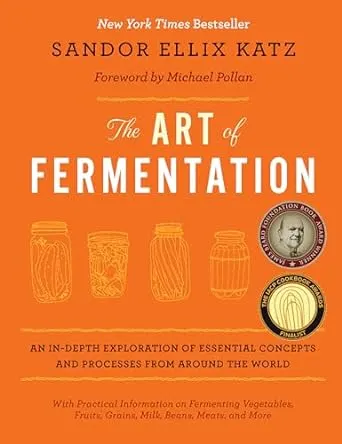
This isn’t just a cookbook—it’s the fermentation bible that has inspired countless practitioners to explore this ancient craft. Katz’s masterwork serves both the novice making their first batch of sauerkraut and the experienced fermenter seeking deeper understanding. Unlike many food books that focus primarily on recipes, The Art of Fermentation takes a different approach, presenting comprehensive processes and principles that allow for creativity and adaptation to your specific circumstances.
Sandor Katz writes with the wisdom of someone who has dedicated decades to both practicing and teaching fermentation. His storytelling weaves together scientific explanations with cultural significance, helping readers understand not just how fermentation works but why it matters. This contextual understanding makes fermentation feel less like a trendy food technique and more like connecting with a vital part of human heritage.
The book explores fermentation through multiple lenses—cultural, historical, nutritional, and even economic. Katz discusses how fermentation has shaped cuisines worldwide and examines its role in food security and community resilience. These broader perspectives are particularly relevant for homesteaders interested in self-sufficiency and traditional skills preservation.
While comprehensive in scope, The Art of Fermentation remains fundamentally practical. You’ll find detailed guidance on fermenting everything from vegetables and dairy to grains, beans, meats, and beyond. Each section includes troubleshooting advice and safety parameters, ensuring your experiments remain both successful and safe. This isn’t a book you’ll read once and shelve—it’s a reference you’ll return to for decades as your fermentation practice evolves and deepens.
For Pickle Enthusiasts
4. The Joy of Pickling by Linda Ziedrich
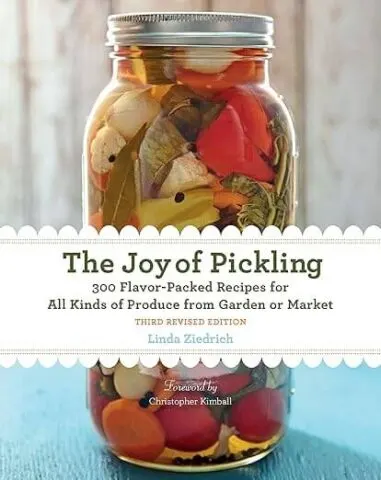
With 300 recipes spanning global traditions, Ziedrich’s updated classic delivers exactly what its title promises—pure pickle joy. This comprehensive guide has been a staple in preserving kitchens for years, and the newest edition expands its scope to include 50 new recipes focused on fermentation techniques alongside traditional vinegar pickling methods.
Ziedrich approaches pickling with scholarly attention to detail but writes with the warmth of someone sharing beloved family recipes. Her historical notes on pickling traditions from around the world add depth to the recipes, connecting you to generations of pickle-makers who came before. These cultural insights help you understand not just how to make a particular pickle but its traditional role and complementary foods.
What sets this book apart is its versatility across preservation methods. You’ll find quick refrigerator pickles for instant gratification when you can’t wait to sample your garden’s bounty. For those planning ahead, traditional canned preserves offer long-term storage solutions perfect for homesteading. The fermented pickle recipes introduce beneficial bacteria that transform flavors while adding probiotic benefits. Having all these techniques in one reference allows you to choose the appropriate method based on your time constraints, ingredients, and desired outcomes.
The Joy of Pickling goes beyond just creating pickles—it teaches you how to use them. Recipes utilizing your pickled creations in salsas, relishes, and other dishes help integrate these preserved foods into your daily cooking. Ziedrich also provides detailed safety guidance, an essential component for any home preserver. From Korean kimchi to Lower East Side dills, the diverse flavor profiles will expand your pickling horizons while building skills that serve any homesteader well.
For the Culinary Explorer
5. The Noma Guide to Fermentation by René Redzepi and David Zilber

From the world-renowned restaurant Noma comes this stunning exploration of fermentation as a flavor frontier. Unlike traditional preservation-focused fermentation books, this guide approaches fermentation primarily as a technique for developing extraordinary flavors. The authors reveal the methods behind Noma’s celebrated taste profiles with meticulous step-by-step photography and clear instructions that make even complex techniques approachable.
René Redzepi and David Zilber bring a chef’s perspective to fermentation, focusing on how these processes can transform ordinary ingredients into something remarkable. The book’s photography is exceptional, illustrating not just the techniques but the stunning visual transformations that occur during fermentation. For homesteaders who appreciate both the practical and aesthetic aspects of food preservation, this book offers inspiration beyond functionality.
The Noma Guide covers seven key fermentation techniques: lacto-fermented fruits and vegetables, kombucha, vinegars, koji, misos and peaso (legume misos), shoyu, and garum. Each section builds your understanding progressively, teaching core principles before advancing to more complex applications. While some projects require special equipment or longer timelines, the authors provide modifications for home kitchens whenever possible.
What truly sets this book apart is how it showcases fermented ingredients in finished dishes. The 100+ recipes demonstrate how these powerhouse flavors can elevate your cooking, from simple applications like dressed vegetables to more elaborate preparations. For homesteaders looking to take their harvest from garden to table in extraordinary ways, this book bridges preservation necessity with culinary artistry. The techniques you’ll learn will revolutionize your approach to familiar ingredients, allowing you to create unique foods deeply connected to your homestead’s seasonal rhythms.
For the Back-to-Basics Homesteader
6. Wild Fermentation by Sandor Ellix Katz
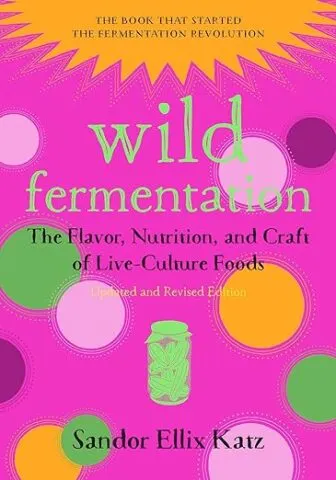
Before writing his comprehensive “Art of Fermentation,” Katz produced this more accessible volume that sparked a modern fermentation revival. Updated with full-color photography, this revised edition retains Katz’s infectious enthusiasm and straightforward approach that has made it a beloved introduction to fermentation for thousands of beginners.
Wild Fermentation stands apart from many modern cookbooks by emphasizing low-tech methods and traditional processes—no special equipment required. This back-to-basics philosophy aligns perfectly with homesteading values of self-reliance and simplicity. Katz writes with the understanding that our ancestors fermented successfully for millennia without precision equipment or scientific understanding, giving readers confidence that they can do the same.
The book covers a diverse range of ferments organized by ingredient categories. From turning milk into cheese or yogurt to transforming grains into sourdough bread, from fermenting beans into miso to creating alcoholic beverages from fruit, Wild Fermentation connects you to food traditions practiced for generations before refrigeration and industrialization. These techniques have sustained communities worldwide during lean times and abundant harvests alike.
What makes this book particularly valuable for homesteaders is its emphasis on working with what you have. Katz encourages adaptation based on your available ingredients, climate, and taste preferences. Rather than rigid recipes, he provides frameworks that empower you to develop a fermentation practice uniquely suited to your homestead’s conditions and seasonality. His personal stories and accessible writing style make this book feel like learning from a friend rather than following a technical manual.
For the DIY Enthusiast
7. DIY Fermentation
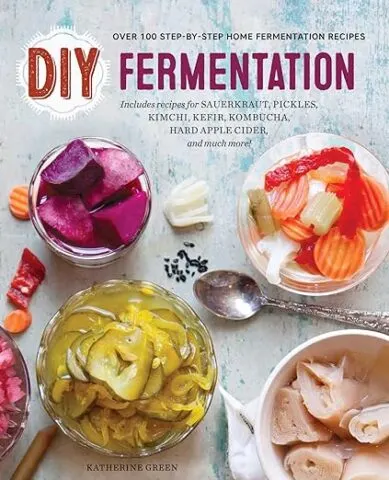
This comprehensive manual delivers exactly what its title promises—over 100 step-by-step recipes covering virtually every fermentation category. Its methodical organization allows you to quickly find processes for whatever ingredients you have in abundance, making it an ideal companion for homesteaders dealing with seasonal harvests and the need to preserve quickly.
What makes this book particularly valuable is its extensive troubleshooting guides that help you navigate common challenges. From kahm yeast on fermented vegetables to separation in milk kefir, the book addresses the issues beginners most frequently encounter. This troubleshooting perspective reflects the reality that fermentation involves living organisms that sometimes behave unexpectedly, preparing you to problem-solve rather than panic when things look different than expected.
DIY Fermentation balances accessibility with depth, making it appropriate for both beginners and those with some experience. The recipes range from quick afternoon projects to more involved processes that develop over weeks or months. This variety helps you match projects to your available time and comfort level as you build skills progressively.
Beyond just recipes, the book offers insights from fermentation experts and clearly illustrates techniques through helpful diagrams and photographs. The bonus chapter on incorporating ferments into everyday cooking is particularly valuable for homesteaders looking to integrate these living foods into their regular meal rotation. Rather than treating ferments as special occasion foods, this practical approach helps you make them part of your sustainable food system.
For the Wild Food Forager
8. Wildcrafted Fermentation by Pascal Baudar
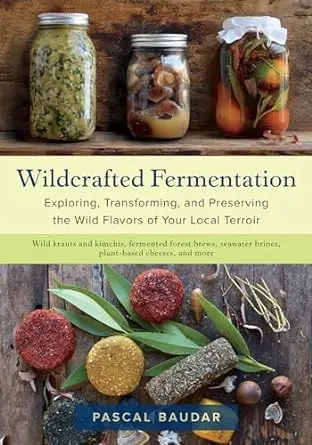
For homesteaders connected to their local landscape, Baudar’s unique approach bridges wild food foraging with fermentation techniques. This groundbreaking book encourages readers to look beyond cultivated ingredients to the abundant wild foods that often grow unnoticed around us. Baudar’s perspective is particularly valuable for those seeking to develop a truly place-based cuisine that reflects their specific bioregion.
Through stunning photography and clear instructions, he demonstrates how to create distinctive ferments from both wild-harvested and garden-grown plants. The step-by-step visual guidance is especially helpful when working with unfamiliar ingredients that might not resemble conventional produce. Baudar provides identification tips for common wild edibles, though he wisely recommends additional foraging resources for those new to wild food gathering.
Wildcrafted Fermentation’s 100+ plant-based recipes go far beyond basic sauerkraut, introducing readers to wild herb kimchis, foraged fruit vinegars, primitive beers, and innovative spice blends. These creations often feature complex flavor profiles impossible to achieve with store-bought ingredients. For the homesteader interested in true food sovereignty, these techniques offer ways to enhance meals using free resources from your landscape while reducing dependence on purchased items.
The philosophical aspects of Baudar’s approach resonate deeply with homesteading values. He emphasizes developing a relationship with your environment through careful observation and sustainable harvesting practices. This book encourages you to see your land not just as a place to grow a garden but as an integrated ecosystem offering diverse food opportunities. Through fermentation of these wild ingredients, you can develop a cuisine unique to your specific location—one that connects you to the seasonal rhythms and distinctive flavors of your homestead’s particular place in the world.
Getting Started
The beauty of fermentation lies in its simplicity—humans were fermenting foods long before they understood the science behind it. This ancient practice doesn’t require fancy equipment or specialist knowledge to begin, making it accessible to everyone regardless of experience level or budget. Many successful fermenters start with nothing more than fresh vegetables, salt, and a clean jar.
Starting small is the wisest approach for beginners. Choose a basic recipe like sauerkraut or quick pickles from one of these guides, and you’ll quickly gain hands-on experience with the fundamentals of fermentation. These entry-level projects typically ferment quickly (within days to a week) and have straightforward success indicators, providing quick feedback on your technique. The confidence you’ll build from these initial successes will motivate you to tackle more complex projects.
The environmental conditions of your homestead will influence your fermentation practice. Temperature affects fermentation speed—warmer environments accelerate the process while cooler temperatures slow it down. Seasonal variations might mean adjusting your techniques throughout the year or focusing on different ferments during different seasons. This responsiveness to natural cycles aligns beautifully with the homesteading ethos of working with nature rather than against it.
Remember that fermentation is both science and art. While these books provide essential guidance, your personal observation and intuition will become increasingly valuable as you gain experience. Record your processes, note what works in your specific environment, and don’t be afraid to adjust recipes to suit your taste and the ingredients available on your homestead. These records will become a treasured resource as you develop your own unique fermentation style.
Which fermentation project will you tackle first? Whether you’re preserving your garden’s abundance or creating probiotic-rich foods for your family’s health, these books will guide you toward success in your fermentation journey. The skills you develop will enhance your homestead’s self-sufficiency while connecting you to traditional food practices that have nourished communities for generations. As you master these techniques, you’ll discover that fermentation isn’t just about preserving food—it’s about transforming simple ingredients into extraordinary flavors impossible to achieve through any other method.

